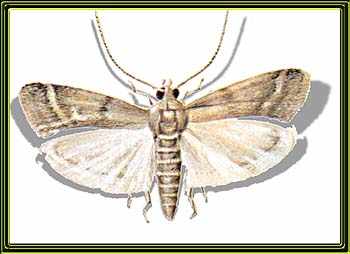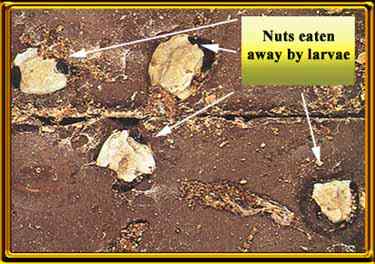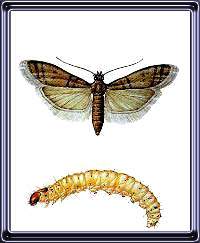
(Warehouse or Cocoa Moth)
This species is closely related to the meal moth, it is very common insect in tropical and temperate climates, but it's taste is more in the way of nuts, almonds, cocoa beans and dried fruit (it is a major pest and also damages flours, milled cereal products, cocoa, etc). It is therefore a very serious pest problem in the chocolate industry. The moths nearly always reach the factory in the raw materials. In addition, the remains of cocoa beans and other materials may be seats of infection, and the machinary itself may harbour povckets of suitable food for these moths.If the moths appear in the factory there is alweays the risk that they may have laid eggs on the finished product, and so one may have the problem of 'worms' in the chocolate (see the picture below, you can't see the worms but you can see where the nuts have been eaten leaving the outlines in the chocolate). The infestation may also take place in a store or shop.
The larvae cannot penetrate hermetically sealed packages, but if there is the slightest gap the female moth, attracted by the scent, will lay eggs nearby and the newly hatched larvae will crawl in and start to feed.
This moth can also eat tobacco. Remarkably enough it can tolerate nicotine, and, together with the tobacco beetle, it is one of the most serious pest in the tobacco industry.
Bilogy:
Eggs are laid over or near the products. Larvae are mobile over products or bags, where they feed and produced silk which may form large webs. When completely grown, they leave the products and move towards the structures or package openings.
Pupae may be immediately formed, becoming adult moths. However, most of them only become adults within a year, keeping the infestation. Adults are short lived and do not feed. They are active at night and usually fly towards the structure’s roofing. They live for 13 to 14 days and a female may lay 279 eggs.
Life cycle takes 50 - 90 days under optimum temperature conditions. The picture below shows the moth again and the larvae.
The treatment is as that for all other stored product insects check out Indian meal moth and Mill moth
Back to main Stored Product Insect page

